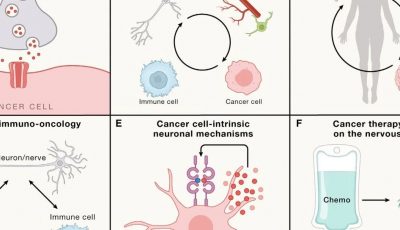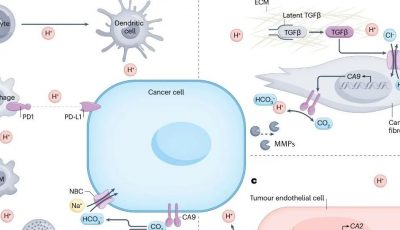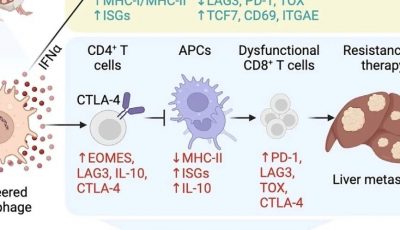01
01 J Hepatol. 20230125
✦
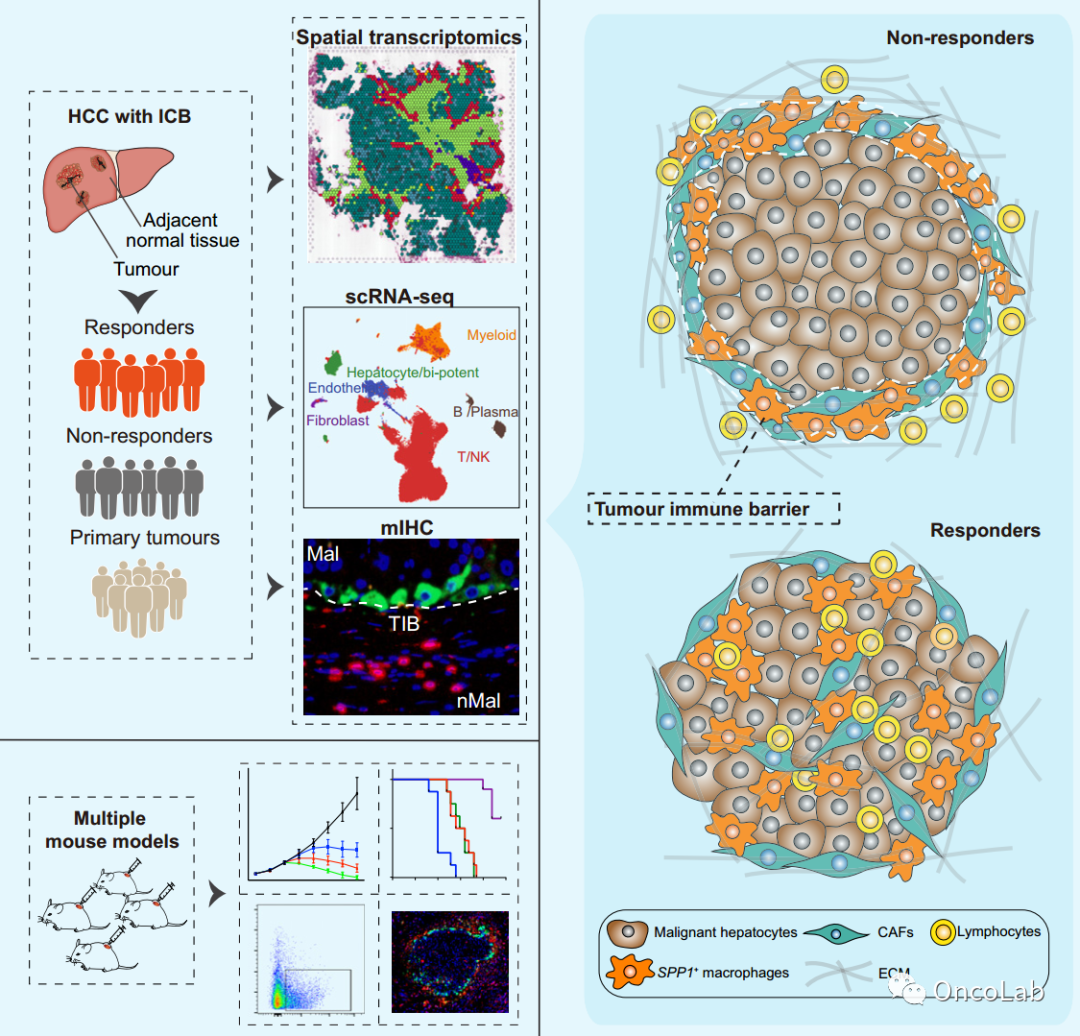
Identification of a tumour immune barrier in the HCC microenvironment that determines the efficacy of immunotherapy
肝癌微环境中存在可决定免疫治疗效果的肿瘤免疫屏障
J Hepatol. 2023 Jan 25;S0168-8278(23)00023-5.
doi: 10.1016/j.jhep.2023.01.011.
PubMed: https://pubmed.ncbi.nlm.nih.gov/36708811/
Abstract
Background & aims: The tumour microenvironment (TME) is a crucial mediator of cancer progression and therapeutic outcome. The TME subtype correlates with patient response to immunotherapy in multiple cancers. Most previous studies have focused on the role of different cellular components in the TME associated with immunotherapy efficacy. However, the specific structure of the TME and its role in immunotherapy efficacy remain largely unknown.
肿瘤微环境(TME)是影响肿瘤进展和治疗效果的关键因素。在多种癌症中,TME亚型与患者对免疫治疗的反应相关。以往的研究大多集中在不同细胞成分在与免疫治疗疗效相关的TME中的作用。然而,TME的具体结构及其在免疫治疗疗效中的作用尚不清楚。
Methods: We combined spatial transcriptomics with single-cell RNA-sequencing and multiplexed immunofluorescence to identify the specific spatial structures in the TME that determine the efficacy of immunotherapy in patients with hepatocellular carcinoma (HCC) receiving anti-PD-1 treatment.
我们将空间转录组学与单细胞RNA测序和多重免疫荧光相结合,以确定在接受抗PD-1治疗的肝细胞癌(HCC)患者TME中决定免疫治疗疗效的特定空间结构。
Results: We identified a tumour immune barrier (TIB) structure, a spatial niche composed of SPP1+ macrophages and cancer-associated fibroblasts (CAFs) located near the tumour boundary, which is associated with the efficacy of immune checkpoint blockade. Furthermore, we dissected ligand‒receptor networks among malignant cells, SPP1+ macrophages, and CAFs; that is, the hypoxic microenvironment promotes SPP1 expression, and SPP1+ macrophages interact with CAFs to stimulate extracellular matrix remodelling and promote TIB structure formation, thereby limiting immune infiltration in the tumour core. Preclinically, the blockade of SPP1 or macrophage-specific deletion of Spp1 in mice led to enhanced efficacy of anti-PD-1 treatment in mouse liver cancer, accompanied by reduced CAF infiltration and increased cytotoxic T-cell infiltration.
我们发现了肿瘤免疫屏障(TIB)结构,这是一个由位于肿瘤边界附近的SPP1+巨噬细胞和癌症相关成纤维细胞(CAFs)组成的空间龛,与免疫检查点阻断的疗效相关。此外,我们剖析了恶性细胞、SPP1+巨噬细胞和CAFs之间的配体-受体网络,发现低氧微环境促进SPP1表达,且SPP1+巨噬细胞与CAFs相互作用,刺激细胞外基质重塑,促进TIB结构形成,从而限制肿瘤核心区的免疫浸润。临床前小鼠模型中,阻断SPP1或巨噬细胞特异性敲除SPP1使得抗PD -1治疗小鼠肝癌的疗效增强,同时伴有CAF浸润减少和细胞毒性T细胞浸润增加。
Conclusions: We identified that the TIB structure formed by the interaction of SPP1+ macrophages and CAFs is related to immunotherapy efficacy. Therefore, disruption of the TIB structure by blocking SPP1 may be considered a relevant therapeutic approach to enhance the therapeutic effect of immune checkpoint blockade in HCC.
我们发现SPP1+巨噬细胞与CAFs相互作用形成的TIB结构与免疫治疗效果相关。因此,通过阻断SPP1破坏TIB结构可能成为增强肝癌免疫检查点阻断治疗效果的治疗方法。
Impact and implications: Only a limited number of patients with hepatocellular carcinoma (HCC) benefit from tumour immunotherapy, which significantly hinders its application. Herein, we used multiomics to identify the spatial structure of the tumour immune barrier (TIB), which is formed by the interaction of SPP1+ macrophages and cancer-associated fibroblasts in the HCC microenvironment. This structure constrains immunotherapy efficacy by limiting immune cell infiltration into malignant regions. Preclinically, we revealed that blocking SPP1 or macrophage-specific deletion of Spp1 in mice could destroy the TIB structure and sensitize HCC cells to immunotherapy. These results provide the first key steps towards finding more effective therapies for HCC and have implications for physicians, scientists, and drug developers in the field of HCC.
只有有限的肝细胞癌(HCC)患者能从肿瘤免疫治疗中获益,这显著阻碍了其应用。在本研究中,我们使用多组学来确定肿瘤免疫屏障(TIB)的空间结构,该屏障是由SPP1+巨噬细胞和肿瘤相关成纤维细胞在HCC微环境中相互作用形成的。这种结构通过限制免疫细胞浸润到恶性区域来限制免疫治疗的效果。临床前,我们发现在小鼠中阻断SPP1或巨噬细胞特异性敲除SPP1可以破坏TIB结构,并使肝癌细胞对免疫治疗增敏。这些结果为寻找更有效的HCC疗法提供了第一个关键步骤,并对HCC领域的医师、科学家和药物开发者产生了影响。
Keywords:
Hepatocellular carcinoma; SPP1(+) macrophage; cancer-associated fibroblast; combination therapy; single cell RNA sequencing; spatial transcriptome; tumour immune barrier.
肝细胞癌;SPP1(+)巨噬细胞;癌症相关成纤维细胞;联合治疗;单细胞RNA测序;空间转录组;肿瘤免疫屏障。
02
Nat Med. 20230126
✦
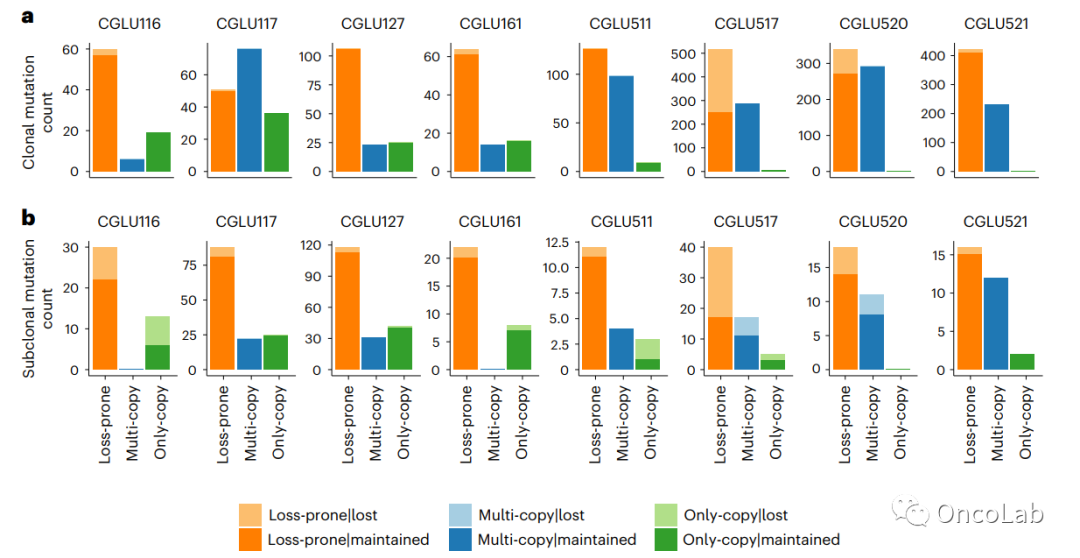
Persistent mutation burden drives sustained anti-tumor immune responses
持续的突变负荷驱动持续的抗肿瘤免疫应答
Nat Med. 2023 Jan 26.
doi: 10.1038/s41591-022-02163-w.
PubMed: https://pubmed.ncbi.nlm.nih.gov/36702947/
Abstract
Tumor mutation burden is an imperfect proxy of tumor foreignness and has therefore failed to consistently demonstrate clinical utility in predicting responses in the context of immunotherapy. We evaluated mutations in regions of the genome that are unlikely to undergo loss in a pan-cancer analysis across 31 tumor types (n = 9,242) and eight immunotherapy-treated cohorts of patients with non-small-cell lung cancer, melanoma, mesothelioma, and head and neck cancer (n = 524). We discovered that mutations in single-copy regions and those present in multiple copies per cell constitute a persistent tumor mutation burden (pTMB) which is linked with therapeutic response to immune checkpoint blockade. Persistent mutations were retained in the context of tumor evolution under selective pressure of immunotherapy and tumors with a high pTMB content were characterized by a more inflamed tumor microenvironment. pTMB imposes an evolutionary bottleneck that cancer cells cannot overcome and may thus drive sustained immunologic tumor control in the context of immunotherapy.
肿瘤突变负荷是反映肿瘤异物性的一个不太完美的指标,因此在预测免疫治疗应答方面未能较好地证明其临床效用。我们在31种肿瘤类型(n = 9,242)和8个接受免疫治疗的非小细胞肺癌、黑色素瘤、间皮瘤和头颈癌(n = 524)患者队列的泛癌症分析中,评估了基因组中不太可能发生缺失的区域的突变。我们发现,单拷贝区域的突变和每个细胞中存在多拷贝的突变构成持续性肿瘤突变负荷(pTMB), pTMB与对免疫检查点阻断的治疗应答相关。在免疫治疗的选择压力下,持续性突变在肿瘤进化的背景下保持,而pTMB含量高的肿瘤具有更炎症的肿瘤微环境特征。pTMB带来了癌细胞无法克服的进化瓶颈,因此可能驱动免疫治疗背景下的持续抗肿瘤免疫。
03
Pharmacol Ther. 20230123
✦
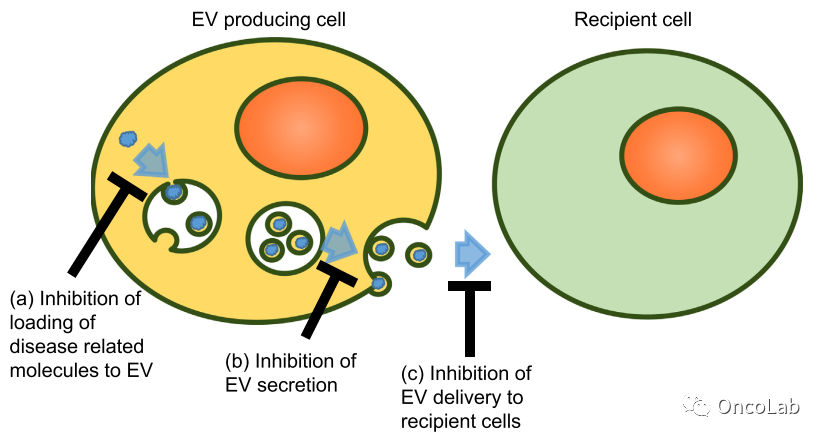
Extracellular vesicle-based therapeutics: Extracellular vesicles as therapeutic targets and agents
基于外泌体的治疗:外泌体作为治疗靶点和药物
Pharmacol Ther. 2023 Jan 23;108352.
doi: 10.1016/j.pharmthera.2023.108352.
PubMed: https://pubmed.ncbi.nlm.nih.gov/36702209/
Abstract
Extracellular vesicles (EVs) are cell-derived membrane vesicles composed of a lipid bilayer. EVs contain biological molecules, such as nucleic acids, lipids, and proteins. As these molecules are transferred to cells that receive EVs, EVs function as intercellular communication tools. EV-mediated intercellular communication is involved in various diseases, such as cancer and neurodegenerative diseases, and biological events, such as immune reactions and inflammation. Therefore, EVs are suggested to be useful as therapeutic targets for various diseases. However, an EV-based drug delivery system (DDS) that utilizes its therapeutic properties has not yet been reported. The biological activities of EVs are derived from their endogenous components; hence, they can be directly applied as drugs. In this review, the basic aspects of EVs, such as their types, methods of isolation, and in vivo behavior, are briefly summarized. Moreover, the potential of using therapeutics targeting EVs has been discussed in cancer and neurodegenerative diseases. Various therapeutics using EVs, including DDSs, are listed and their associated advantages and challenges are discussed.
外泌体(Extracellular vesicles, EVs)是由脂质双分子层组成的细胞源性膜性囊泡。EVs含有核酸、脂质和蛋白质等生物分子。当这些分子被转移到接受EVs的细胞时,EVs就成为细胞间通讯的工具。EV介导的细胞间通讯参与多种疾病,如癌症、神经退行性疾病等,以及免疫反应、炎症等生物学事件。因此,EVs被认为是多种疾病的有效治疗靶点。然而,利用其治疗特性的基于EV的药物递送系统(DDS)尚未见报道。EVs的生物活性来源于其内源性成分;因此,它们可以直接作为药物应用。本文就EVs的类型、分离方法及在体行为等方面的研究进展作一综述。此外,针对EVs的治疗药物在癌症和神经退行性疾病中的应用也得到了讨论。本文列出了使用EVs(包括DDSs)的各种治疗方法,并讨论了其相关的优势和挑战。
04
Nat Rev Drug Discov. 20230124
✦
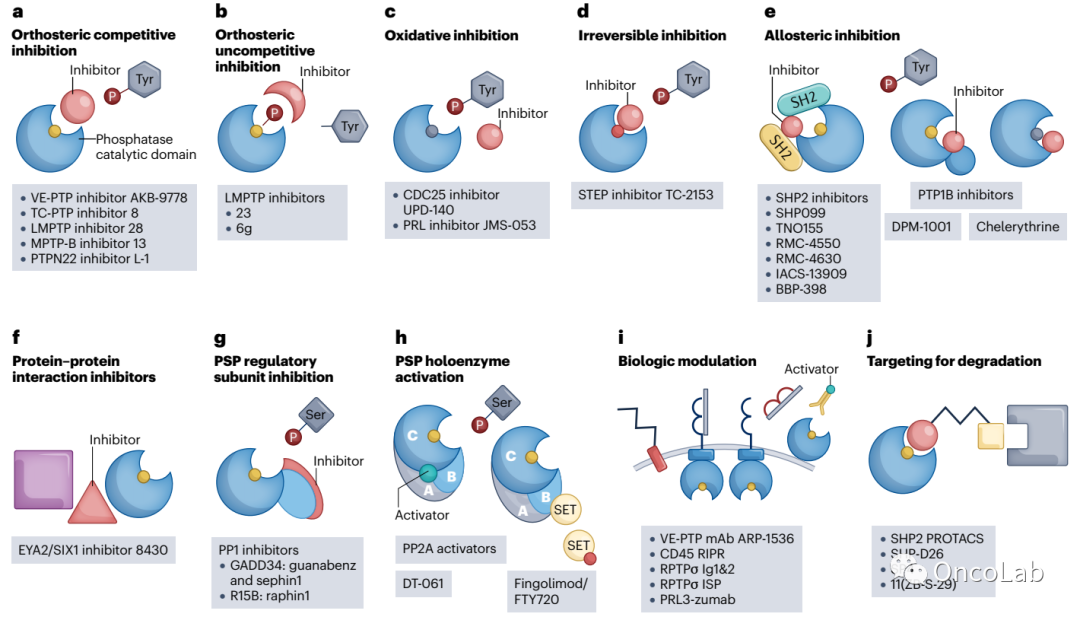
Targeting protein phosphatases in cancer immunotherapy and autoimmune disorders
肿瘤免疫治疗和自身免疫性疾病中靶向蛋白磷酸酶
Nat Rev Drug Discov. 2023 Jan 24;1-22.
doi: 10.1038/s41573-022-00618-w.
PubMed: https://pubmed.ncbi.nlm.nih.gov/36693907/
Abstract
Protein phosphatases act as key regulators of multiple important cellular processes and are attractive therapeutic targets for various diseases. Although extensive effort has been dedicated to phosphatase-targeted drug discovery, early expeditions for competitive phosphatase inhibitors were plagued by druggability issues, leading to the stigmatization of phosphatases as difficult targets. Despite challenges, persistent efforts have led to the identification of several drug-like, non-competitive modulators of some of these enzymes – including SH2 domain-containing protein tyrosine phosphatase 2, protein tyrosine phosphatase 1B, vascular endothelial protein tyrosine phosphatase and protein phosphatase 1 – reigniting interest in therapeutic targeting of phosphatases. Here, we discuss recent progress in phosphatase drug discovery, with emphasis on the development of selective modulators that exhibit biological activity. The roles and regulation of protein phosphatases in immune cells and their potential as powerful targets for immuno-oncology and autoimmunity indications are assessed.
蛋白磷酸酶是多种重要细胞过程的关键调节因子,也是各种疾病中有吸引力的治疗靶点。尽管在磷酸酶靶向药物的发现方面已经付出了大量的努力,但早期竞争性磷酸酶抑制剂的开发受到药物敏感性问题的困扰,导致磷酸酶被称为困难的靶点。尽管存在挑战,但通过不懈努力,我们发现了其中一些酶的几种类药物、非竞争性调节剂(包括包含SH2结构域的蛋白酪氨酸磷酸酶2、蛋白酪氨酸磷酸酶1B、血管内皮蛋白酪氨酸磷酸酶和蛋白磷酸酶1),这重新点燃了人们对磷酸酶靶向治疗的兴趣。本文综述了磷酸酶类药物的研究进展,重点介绍了具有生物活性的选择性磷酸酶调节剂的开发。评估免疫细胞中蛋白磷酸酶的作用和调节,以及它们作为免疫肿瘤和自身免疫适应证的强大靶点的潜力。
05
Cell. 20230119
✦
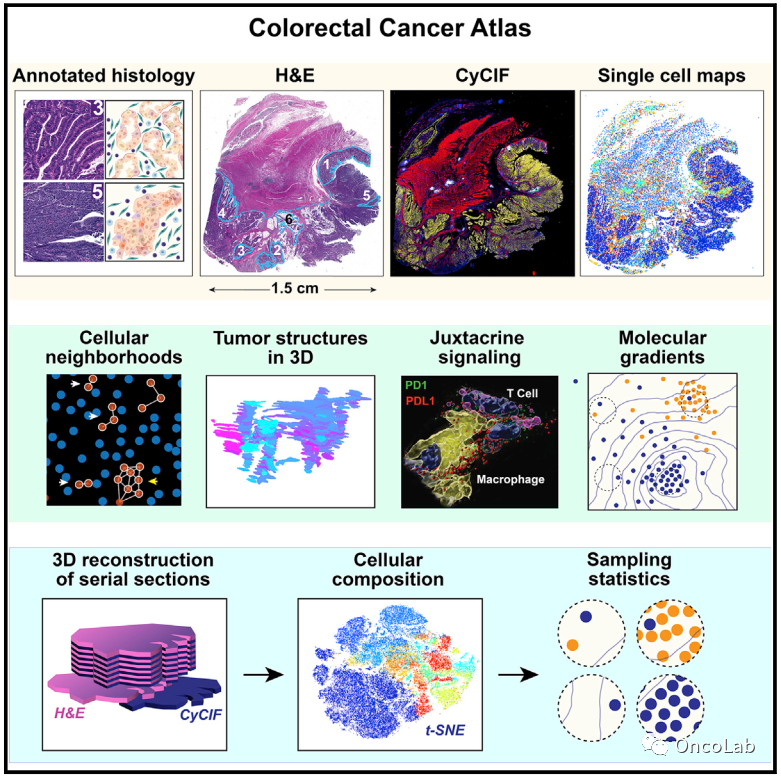
Multiplexed 3D atlas of state transitions and immune interaction in colorectal cancer
结直肠癌状态转换和免疫相互作用的多重3D图谱
Cell. 2023 Jan 19;186(2):363-381.e19.
doi: 10.1016/j.cell.2022.12.028.
PubMed: https://pubmed.ncbi.nlm.nih.gov/36669472/
Abstract
Advanced solid cancers are complex assemblies of tumor, immune, and stromal cells characterized by high intratumoral variation. We use highly multiplexed tissue imaging, 3D reconstruction, spatial statistics, and machine learning to identify cell types and states underlying morphological features of known diagnostic and prognostic significance in colorectal cancer. Quantitation of these features in high-plex marker space reveals recurrent transitions from one tumor morphology to the next, some of which are coincident with long-range gradients in the expression of oncogenes and epigenetic regulators. At the tumor invasive margin, where tumor, normal, and immune cells compete, T cell suppression involves multiple cell types and 3D imaging shows that seemingly localized 2D features such as tertiary lymphoid structures are commonly interconnected and have graded molecular properties. Thus, while cancer genetics emphasizes the importance of discrete changes in tumor state, whole-specimen imaging reveals large-scale morphological and molecular gradients analogous to those in developing tissues.
晚期实体癌是肿瘤、免疫和间质细胞的复杂组合,其特征是瘤内高度变异。我们使用高度多重的组织成像、3D重建、空间统计和机器学习来识别结直肠癌中具有已知诊断和预后意义的形态特征基础上的细胞类型和状态。在高通量标记空间对这些特征进行定量分析,揭示了从一种肿瘤形态到下一种肿瘤形态的反复转变,其中一些与癌基因和表观遗传调节因子表达的长期梯度一致。在肿瘤浸润边缘,肿瘤细胞、正常细胞和免疫细胞相互竞争,T细胞抑制涉及多种细胞类型,3D成像显示看似局限的2D特征(如三级淋巴结构)通常相互连接,并具有分级的分子特性。因此,虽然癌症遗传学强调了肿瘤状态离散变化的重要性,但全样本成像揭示了与发育组织类似的大规模形态和分子梯度。
Keywords:
3D microscopy; PD1-PDL1 interaction; cellular; colorectal cancer; intermixed molecular; large-scale; morphological features; multiplexed imaging; spatial gradients; spatial proteomics; spatial transcriptomics; tertiary lymphoid structures; tumor atlas; tumor budding.
三维显微镜;PD1-PDL1互作;细胞;结直肠癌;混杂在一起的分子;大规模的;形态学特征;多重成像;空间梯度;空间蛋白质组学;空间转录组;三级淋巴结构;肿瘤图谱;肿瘤萌芽。
06
Nat Med. 20230119
✦
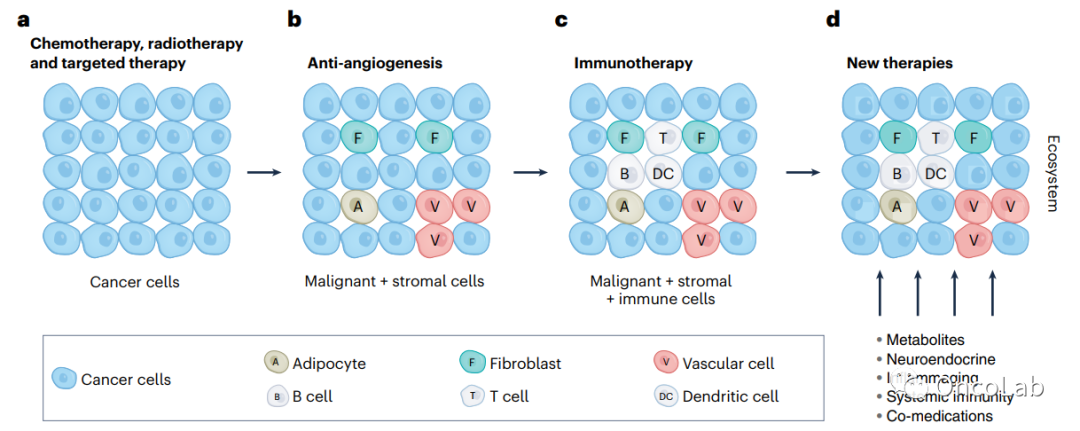
Bodywide ecological interventions on cancer
癌症的全身生态干预
Nat Med. 2023 Jan 19.
doi: Nat Med. 2023 Jan 19.
PubMed: https://pubmed.ncbi.nlm.nih.gov/36658422/
Abstract
Historically, cancer research and therapy have focused on malignant cells and their tumor microenvironment. However, the vascular, lymphatic and nervous systems establish long-range communication between the tumor and the host. This communication is mediated by metabolites generated by the host or the gut microbiota, as well by systemic neuroendocrine, pro-inflammatory and immune circuitries-all of which dictate the trajectory of malignant disease through molecularly defined biological mechanisms. Moreover, aging, co-morbidities and co-medications have a major impact on the development, progression and therapeutic response of patients with cancer. In this Perspective, we advocate for a whole-body ‘ecological’ exploration of malignant disease. We surmise that accumulating knowledge on the intricate relationship between the host and the tumor will shape rational strategies for systemic, bodywide interventions that will eventually improve tumor control, as well as quality of life, in patients with cancer.
历史上,癌症的研究和治疗主要集中在恶性细胞及其肿瘤微环境。然而,血管、淋巴和神经系统在肿瘤与宿主之间建立了长程通讯。这种交流由宿主或肠道菌群产生的代谢物,以及全身神经内分泌、促炎和免疫回路介导,所有这些都通过分子定义的生物学机制决定恶性疾病的轨迹。此外,年龄、合并症和联合用药对癌症患者的发生、发展和治疗反应有重要影响。在这一视角下,我们提倡对恶性疾病进行全身的“生态”探索。我们推测,随着对宿主和肿瘤之间错综复杂关系的认识不断积累,我们将制定合理的策略,实施全身性的干预措施,最终改善癌症患者的肿瘤控制和生活质量。
07
Neuro Oncol. 20230119
✦

Single-cell transcriptomic analyses provide insights into the cellular origins and drivers of brain metastasis from lung adenocarcinoma
单细胞转录组分析为肺腺癌脑转移的细胞起源和驱动因素提供了见解
Neuro Oncol. 2023 Jan 19;noad017.
doi: 10.1093/neuonc/noad017.
PubMed: https://pubmed.ncbi.nlm.nih.gov/36656750/
Abstract
Background: Brain metastasis (BM) is the most common intracranial malignancy causing significant mortality, and lung cancer is the most common origin of BM. However, the cellular origins and drivers of BM from lung adenocarcinoma (LUAD) have yet to be defined.
脑转移(BM)是最常见的颅内恶性肿瘤,死亡率高,肺癌是最常见的BM来源。然而,肺腺癌骨髓的细胞起源和驱动因素尚未明确。
Methods: The cellular constitutions were characterized by single-cell transcriptomic profiles of 11 LUAD primary tumor (PT) and 10 BM samples (GSE131907). Copy number variation (CNV) and clonality analysis were applied to illustrate cellular origins of BM tumors. Brain metastasis-associated epithelial cells (BMAECs) were identified by pseudotime trajectory analysis. By using machine-learning algorithms, we developed the BM-index representing the relative abundance of BMAECs in the bulk RNA-seq data, indicating high risk of BM. Therapeutic drugs targeting BMAECs were predicted based on the drug sensitivity data of cancer cell lines.
通过11例肺腺癌原发肿瘤(PT)和10例肺腺癌骨髓(GSE131907)的单细胞转录组谱,分析其细胞组成。应用拷贝数变异(CNV)和克隆性分析来说明骨髓肿瘤的细胞起源。通过逆时序轨迹分析鉴定脑转移相关上皮细胞(BMAECs)。通过机器学习算法,我们建立了代表大样本RNA-seq数据中BMAECs相对丰度的BM指数(BM-index),该指数越高表明BM风险越高。根据肿瘤细胞系药物敏感性数据预测靶向BMAECs的治疗药物。
Results: Differences in macrophages and T cells between PTs and BMs were investigated by single-cell RNA (scRNA) and immunohistochemistry and immunofluorescence data. CNV analysis demonstrated BM was derived from subclones of PT with a gain of chromosome 7. We then identified BMAECs and its biomarker, S100A9. Immunofluorescence indicated strong correlations of BMAECs with metastasis and prognosis evaluated by the paired PT and BM samples from Peking Union Medical College Hospital (PUMCH). We further evaluated the clinical significance of BM-index and identified 7 drugs that potentially target BMAECs.
通过单细胞RNA (scRNA)、免疫组织化学和免疫荧光数据研究PTs和BMs之间巨噬细胞和T细胞的差异。CNV分析显示骨髓来源于获得7号染色体的PT亚克隆。然后我们鉴定了BMAECs及其生物标志物S100A9。北京协和医院配对的PT和BM标本免疫荧光结果显示,BMAECs与转移和预后密切相关。我们进一步评估了BM-index的临床意义,并确定了7种潜在的靶向BMAECs的药物。
Conclusions: This study clarified possible cellular origins and drivers of metastatic LUAD at single cell level, and laid a foundation for early detections of LUAD patients with a high risk of BM.
本研究在单细胞水平上阐明了转移性LUAD可能的细胞来源和驱动因素,为早期发现BM高风险LUAD患者奠定了基础。
Keywords:
Brain metastasis; Immune microenvironment; Lung adenocarcinoma; S100A9; scRNA-seq.
脑转移;免疫微环境;肺腺癌;S100A9;scRNA-seq。
08
Cancer Discov. 20230117
✦
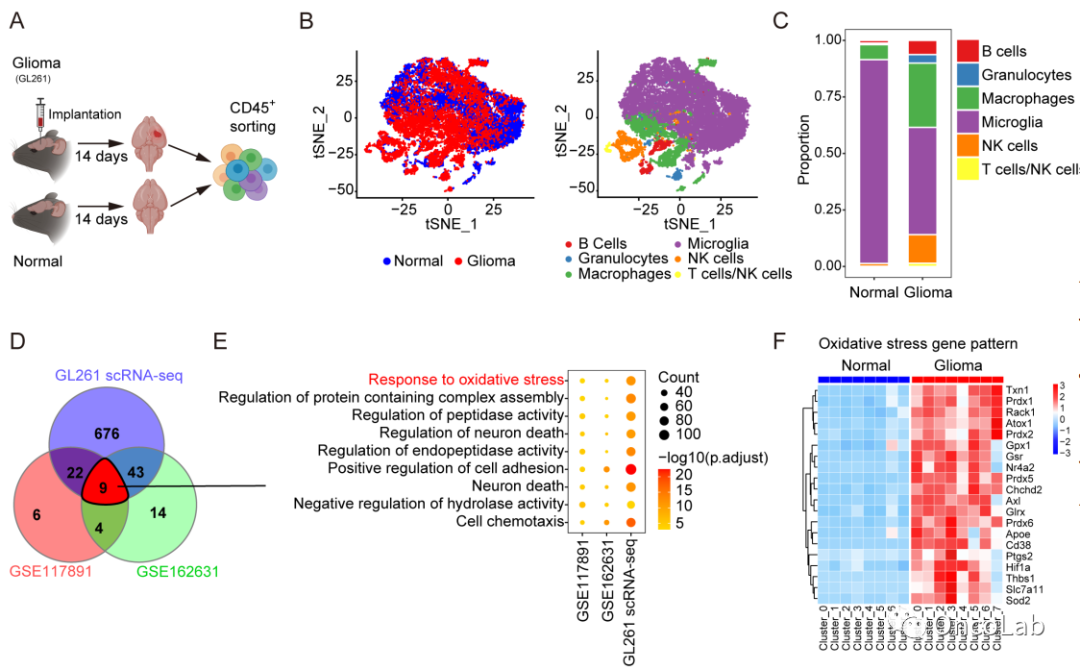
Targeting Microglial Metabolic Rewiring Synergizes with Immune Checkpoint Blockade Therapy for Glioblastoma
在胶质母细胞瘤中靶向小胶质细胞代谢重组对免疫检查点阻断疗法有增效作用
Cancer Discov. 2023 Jan 17;CD-22-0455.
doi: 10.1158/2159-8290.CD-22-0455.
PubMed: https://pubmed.ncbi.nlm.nih.gov/36649564/
Abstract
Glioblastoma (GBM) constitutes the most lethal primary brain tumor for which immunotherapy has provided limited benefit. The unique brain immune landscape is reflected in a complex tumor immune microenvironment (TIME) in GBM. Here, single cell sequencing of the GBM TIME revealed that microglia were under severe oxidative stress, which induced nuclear receptor subfamily 4 group A member 2 (NR4A2)-dependent transcriptional activity in microglia. Heterozygous Nr4a2 (Nr4a2+/-) or microglia-specific Nr4a2 (Nr4a2fl/flCx3cr1cre) genetic targeting reshaped microglia plasticity in vivo by reducing alternatively activated microglia and enhancing antigen presentation capacity for CD8+ T cells in GBM. In microglia, NR4A2 activated squalene monooxygenase (SQLE) to dysregulate cholesterol homeostasis. Pharmacological NR4A2 inhibition attenuated the pro-tumorigenic TIME, and targeting the NR4A2 or SQLE enhanced therapeutic efficacy of immune checkpoint blockade in vivo. Collectively, oxidative stress promotes tumor growth through NR4A2-SQLE activity in microglia, informing novel immune therapy paradigms in brain cancer.
胶质母细胞瘤(GBM)是最致命的原发性脑肿瘤,免疫治疗对其疗效有限。GBM复杂的肿瘤免疫微环境(tumor immune microenvironment, TIME)反映了独特的脑免疫景观。在这里,GBM TIME的单细胞测序显示,小胶质细胞处于严重的氧化应激中,这诱导了小胶质细胞中核受体亚家族4A成员2 (NR4A2)依赖的转录活性。杂合子Nr4a2 (Nr4a2+/-)或小胶质细胞特异性Nr4a2 (Nr4a2fl/flCx3cr1cre)基因靶向敲除通过减少GBM中激活的小胶质细胞和增强CD8+ T细胞的抗原提呈能力来重塑体内小胶质细胞的可塑性。在小胶质细胞中,NR4A2激活角鲨烯单加氧酶(SQLE),导致胆固醇稳态失调。药理抑制NR4A2减弱了促肿瘤发生的TIME,靶向NR4A2或SQLE增强了免疫检查点阻断在体内的治疗效果。综上所述,氧化应激通过NR4A2-SQLE在小胶质细胞中的活性促进肿瘤生长,为脑癌的新型免疫治疗提供了新的思路。
09
Signal Transduct Target Ther. 20230116
✦
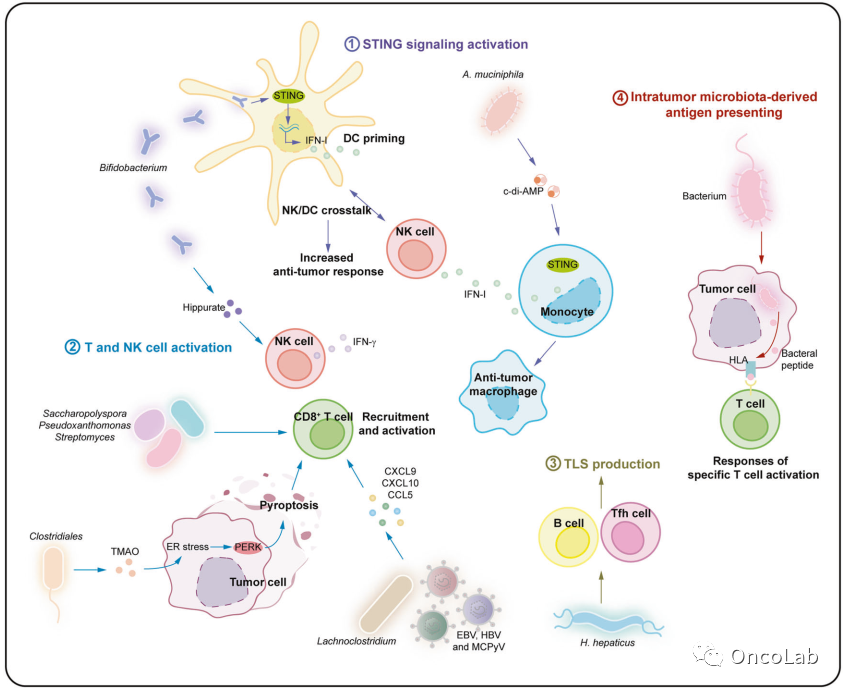
Intratumoral microbiota: roles in cancer initiation, development and therapeutic efficacy
瘤内微生物群:在癌症发生、发展和治疗效果中的作用
Signal Transduct Target Ther. 2023 Jan 16;8(1):35.
doi: 10.1038/s41392-022-01304-4.
PubMed: https://pubmed.ncbi.nlm.nih.gov/36646684/
Abstract
Microorganisms, including bacteria, viruses, fungi, and other eukaryotes, play critical roles in human health. An altered microbiome can be associated with complex diseases. Intratumoral microbial components are found in multiple tumor tissues and are closely correlated with cancer initiation and development and therapy efficacy. The intratumoral microbiota may contribute to promotion of the initiation and progression of cancers by DNA mutations, activating carcinogenic pathways, promoting chronic inflammation, complement system, and initiating metastasis. Moreover, the intratumoral microbiota may not only enhance antitumor immunity via mechanisms including STING signaling activation, T and NK cell activation, TLS production, and intratumoral microbiota-derived antigen presenting, but also decrease antitumor immune responses and promote cancer progression through pathways including upregulation of ROS, promoting an anti-inflammatory environment, T cell inactivation, and immunosuppression. The effect of intratumoral microbiota on antitumor immunity is dependent on microbiota composition, crosstalk between microbiota and the cancer, and status of cancers. The intratumoral microbiota may regulate cancer cell physiology and the immune response by different signaling pathways, including ROS, β-catenin, TLR, ERK, NF-κB, and STING, among others. These viewpoints may help identify the microbiota as diagnosis or prognosis evaluation of cancers, and as new therapeutic strategy and potential therapeutic targets for cancer therapy.
微生物,包括细菌、病毒、真菌和其他真核生物,在人类健康中发挥着关键作用。微生物组的改变可能与复杂疾病相关。肿瘤内微生物成分存在于多种肿瘤组织中,与肿瘤的发生、发展及治疗效果密切相关。肿瘤内微生物群可能通过DNA突变、激活致癌通路、促进慢性炎症、补体系统和启动转移等方式促进癌症的发生和发展。此外,肿瘤内微生物群不仅可以通过STING信号激活、T细胞和NK细胞活化、TLS产生和肿瘤内微生物群来源的抗原提呈等机制增强抗肿瘤免疫,还可以通过上调ROS、促进抗炎环境、T细胞失活和免疫抑制等途径降低抗肿瘤免疫反应和促进肿瘤进展。肿瘤内微生物群对抗肿瘤免疫的作用依赖于微生物群的组成、微生物群与肿瘤之间的交互作用以及肿瘤的状态。肿瘤内菌群可能通过ROS、β-catenin、TLR、ERK、NF-κB和STING等不同的信号通路调节肿瘤细胞生理和免疫反应。这些观点可能有助于识别微生物群作为癌症的诊断或预后评估,并作为新的治疗策略和潜在的治疗靶点。
10
Nat Rev Clin Oncol. 20230113
✦
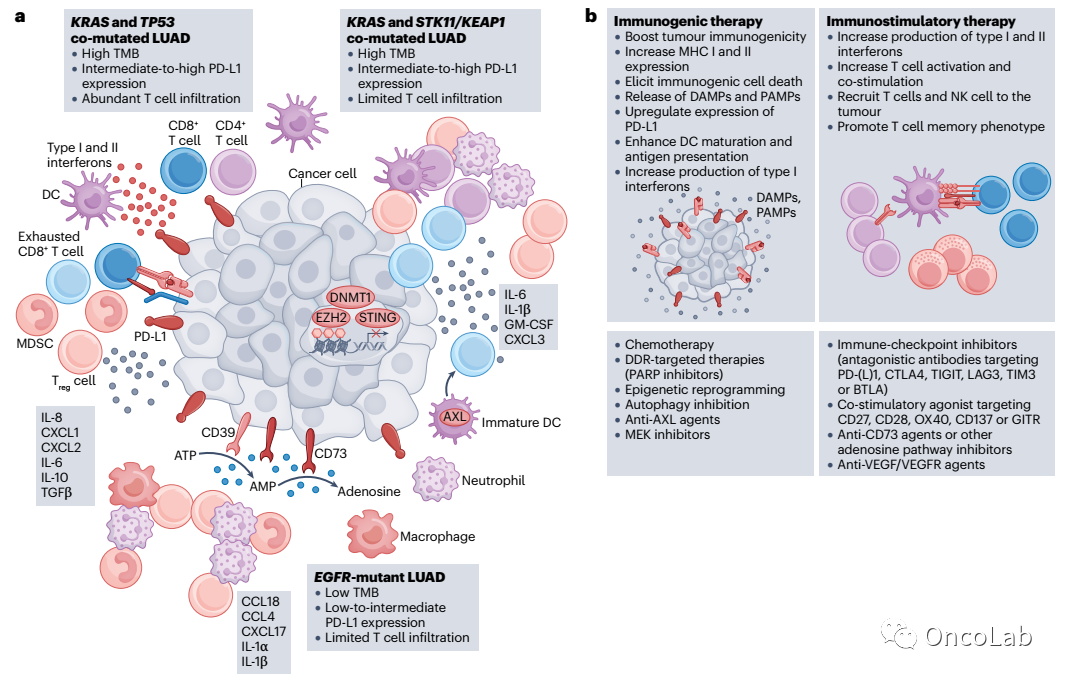
At the crossroads of immunotherapy for oncogene-addicted subsets of NSCLC
癌基因依赖的NSCLC亚型的免疫治疗
Nat Rev Clin Oncol. 2023 Jan 13.
doi: 10.1038/s41571-022-00718-x.
PubMed: https://pubmed.ncbi.nlm.nih.gov/36639452/
Abstract
Non-small-cell lung cancer (NSCLC) has become a paradigm of precision medicine, with the discovery of numerous disease subtypes defined by specific oncogenic driver mutations leading to the development of a range of molecularly targeted therapies. Over the past decade, rapid progress has also been made in the development of immune-checkpoint inhibitors (ICIs), especially antagonistic antibodies targeting the PD-L1-PD-1 axis, for the treatment of NSCLC. Although many of the major oncogenic drivers of NSCLC are associated with intrinsic resistance to ICIs, patients with certain oncogene-driven subtypes of the disease that are highly responsive to specific targeted therapies might also derive benefit from immunotherapy. However, the development of effective immunotherapy approaches for oncogene-addicted NSCLC has been challenged by a lack of predictive biomarkers for patient selection and limited knowledge of how ICIs and oncogene-directed targeted therapies should be combined. Therefore, whether ICIs alone or with chemotherapy or even in combination with molecularly targeted agents would offer comparable benefit in the context of selected oncogenic driver alterations to that observed in the general unselected NSCLC population remains an open question. In this Review, we discuss the effects of oncogenic driver mutations on the efficacy of ICIs and the immune tumour microenvironment as well as the potential vulnerabilities that could be exploited to overcome the challenges of immunotherapy for oncogene-addicted NSCLC.
非小细胞肺癌(Non-small-cell lung cancer, NSCLC)已成为精准医学的典范,多种由特定致癌驱动突变定义的疾病亚型被发现,导致一系列分子靶向治疗的开发。在过去的十年中,免疫检查点抑制剂(ICI),尤其是靶向PD-L1-PD-1轴的拮抗抗体在NSCLC治疗方面也取得了快速进展。虽然NSCLC的许多主要致癌驱动因素与ICI的固有耐药相关,但某些癌基因驱动的疾病亚型中对特异性靶向治疗有高度应答的患者也可能从免疫治疗中获益。然而,由于缺乏可用于患者选择的预测性生物标志物,以及对于ICI和癌基因导向的靶向治疗如何结合的知识有限,对癌基因依赖性NSCLC有效免疫治疗方法的开发面临挑战。因此,在经过选择的致癌驱动改变的背景下,ICI单药或与化疗联用,甚至与与分子靶向药物联用的获益是否与在一般非经过选择的NSCLC人群中观察到的获益相当仍然是一个悬而未决的问题。在这篇综述中,我们讨论了致癌驱动突变对ICIs疗效和肿瘤免疫微环境的影响以及可以利用的潜在弱点,来克服癌基因依赖的NSCLC免疫治疗中遇到的挑战。
11
Sci Adv. 20230113
✦

Escape from NK cell tumor surveillance by NGFR-induced lipid remodeling in melanoma
在黑色素瘤中NGFR诱导的脂质重塑使得肿瘤细胞逃脱NK细胞免疫监视
Sci Adv. 2023 Jan 13;9(2):eadc8825. Epub 2023 Jan
doi: 10.1126/sciadv.adc8825.
PubMed: https://pubmed.ncbi.nlm.nih.gov/36638181/
Abstract
Metastatic disease is a major cause of death for patients with melanoma. Melanoma cells can become metastatic not only due to cell-intrinsic plasticity but also due to cancer-induced protumorigenic remodeling of the immune microenvironment. Here, we report that innate immune surveillance by natural killer (NK) cells is bypassed by human melanoma cells expressing the stem cell marker NGFR. Using in vitro and in vivo cytotoxic assays, we show that NGFR protects melanoma cells from NK cell-mediated killing and, furthermore, boosts metastasis formation in a mouse model with adoptively transferred human NK cells. Mechanistically, NGFR leads to down-regulation of NK cell activating ligands and simultaneous up-regulation of the fatty acid stearoyl-coenzyme A desaturase (SCD) in melanoma cells. Notably, pharmacological and small interfering RNA-mediated inhibition of SCD reverted NGFR-induced NK cell evasion in vitro and in vivo. Hence, NGFR orchestrates immune control antagonizing pathways to protect melanoma cells from NK cell clearance, which ultimately favors metastatic disease.
转移性疾病是黑色素瘤患者死亡的主要原因。黑色素瘤细胞可以转移不仅由于细胞内在的可塑性,而且由于癌症诱导的促癌性免疫微环境的形成。在这里,我们报道了自然杀伤(NK)细胞的固有免疫监视被表达干细胞标记物NGFR的人黑色素瘤细胞所避开。通过体外和体内细胞毒性实验,我们发现NGFR保护黑色素瘤细胞免受NK细胞介导的杀伤作用,并且在过继转移的人NK细胞的小鼠模型中促进转移形成。在机制上,NGFR导致黑色素瘤细胞中NK细胞活化配体的下调和脂肪酸硬脂酰辅酶A去饱和酶(SCD)的上调。值得注意的是,在体内外实验中,药物和小干扰RNA介导的SCD抑制逆转了NGFR诱导的NK细胞逃逸。因此,NGFR利用免疫控制拮抗通路,保护黑色素瘤细胞免受NK细胞清除,最终促使了转移性疾病的发生。
12
Nature. 20230112
✦
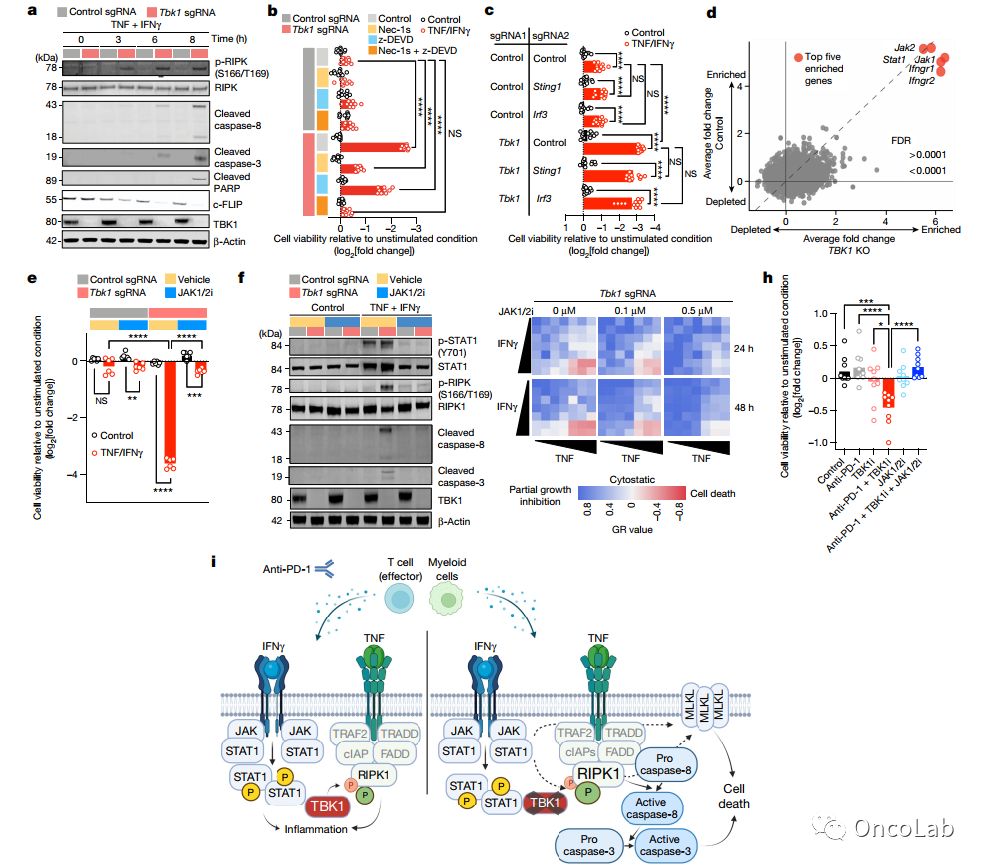
Targeting TBK1 to overcome resistance to cancer immunotherapy
靶向TBK1可克服癌症免疫治疗的耐药性
Nature. 2023 Jan 12.
doi: 10.1038/s41586-023-05704-6.
PubMed: https://pubmed.ncbi.nlm.nih.gov/36634707/
Abstract
Despite the success of PD-1 blockade in melanoma and other cancers, effective treatment strategies to overcome resistance to cancer immunotherapy are lacking. Here we identify the innate immune kinase TANK-binding kinase 1 (TBK1)3 as a candidate immune-evasion gene in a pooled genetic screen. Using a suite of genetic and pharmacological tools across multiple experimental model systems, we confirm a role for TBK1 as an immune-evasion gene. Targeting TBK1 enhances responses to PD-1 blockade by decreasing the cytotoxicity threshold to effector cytokines (TNF and IFNγ). TBK1 inhibition in combination with PD-1 blockade also demonstrated efficacy using patient-derived tumour models, with concordant findings in matched patient-derived organotypic tumour spheroids and matched patient-derived organoids. Tumour cells lacking TBK1 are primed to undergo RIPK- and caspase-dependent cell death in response to TNF and IFNγ in a JAK-STAT-dependent manner. Taken together, our results demonstrate that targeting TBK1 is an effective strategy to overcome resistance to cancer immunotherapy.
尽管PD-1阻断在黑色素瘤和其他癌症中取得了成功,但目前仍缺乏克服癌症免疫治疗耐药性的有效治疗策略。在这里,我们在遗传筛选中确定了固有免疫激酶TANK结合激酶1 (TBK1)是一个候选免疫逃避基因。使用跨多个实验模型的一套遗传和药理学工具,我们证实了TBK1作为免疫逃逸基因的作用。通过降低对效应细胞因子(TNF和IFNγ)的细胞毒性阈值,靶向TBK1增强了对PD-1阻断的应答。TBK1抑制联合PD-1阻断也在患者来源的肿瘤模型中证明了疗效,匹配的患者来源的器官型肿瘤球体和类器官得到了一致的发现。缺乏TBK1的肿瘤细胞以JAK-STAT依赖的方式对TNF和IFNγ应答而经历RIPK和caspase依赖的细胞死亡。综上所述,我们的研究结果表明,靶向TBK1是克服肿瘤免疫治疗耐药的有效策略。
13
Nature. 20230111
✦

γδ T cells are effectors of immunotherapy in cancers with HLA class I defects
γδ T细胞是HLA-I缺陷型癌症免疫治疗的效应细胞
Nature. 2023 Jan 11.
doi: 10.1038/s41586-022-05593-1.
PubMed: https://pubmed.ncbi.nlm.nih.gov/36631610/
Abstract
DNA mismatch repair-deficient (MMR-d) cancers present an abundance of neoantigens that is thought to explain their exceptional responsiveness to immune checkpoint blockade (ICB). Here, in contrast to other cancer types, we observed that 20 out of 21 (95%) MMR-d cancers with genomic inactivation of β2-microglobulin (encoded by B2M) retained responsiveness to ICB, suggesting the involvement of immune effector cells other than CD8+ T cells in this context. We next identified a strong association between B2M inactivation and increased infiltration by γδ T cells in MMR-d cancers. These γδ T cells mainly comprised the Vδ1 and Vδ3 subsets, and expressed high levels of PD-1, other activation markers, including cytotoxic molecules, and a broad repertoire of killer-cell immunoglobulin-like receptors. In vitro, PD-1+ γδ T cells that were isolated from MMR-d colon cancers exhibited enhanced reactivity to human leukocyte antigen (HLA)-class-I-negative MMR-d colon cancer cell lines and B2M-knockout patient-derived tumour organoids compared with antigen-presentation-proficient cells. By comparing paired tumour samples from patients with MMR-d colon cancer that were obtained before and after dual PD-1 and CTLA-4 blockade, we found that immune checkpoint blockade substantially increased the frequency of γδ T cells in B2M-deficient cancers. Taken together, these data indicate that γδ T cells contribute to the response to immune checkpoint blockade in patients with HLA-class-I-negative MMR-d colon cancers, and underline the potential of γδ T cells in cancer immunotherapy.
DNA错配修复缺陷(MMR-d)癌症存在大量新抗原,这被认为可以解释它们对免疫检查点阻断(ICB)的较强的反应。在本研究中,与其他类型的癌症不同,我们观察到在21例β2-微球蛋白(由B2M编码)基因组失活的MMR-d癌症中,有20例(95%)保留了对ICB的反应性,这表明在这种情况下,除了CD8+ T细胞之外,还有免疫效应细胞参与。接下来,我们发现MMR-d肿瘤中B2M失活和γδ T细胞浸润增加之间的强关联。这些γδ T细胞主要由Vδ1和Vδ3亚群组成,高水平表达PD-1、其他活化标志物(包括细胞毒性分子)和广泛的杀伤细胞免疫球蛋白样受体。在体外,从MMR-d结肠癌中分离出的PD-1+ γδ T细胞对人类白细胞抗原(HLA)-I阴性的MMR-d结肠癌细胞系和b2m敲除患者来源的肿瘤类器官的反应性高于抗原呈递功能正常的细胞。通过比较PD-1和CTLA-4双重阻断之前和之后获得的MMR-d结肠癌患者配对肿瘤样本,我们发现免疫检查点阻断显著增加了B2M缺陷癌症中γδ T细胞的频率。综上所述,这些数据表明,γδ T细胞有助于HLA-I阴性MMR-d结肠癌患者对免疫检查点阻断的应答,并强调了γδ T细胞在癌症免疫治疗中的潜力。
14
Cell Res. 20230110
✦

Targeting ATAD3A-PINK1-mitophagy axis overcomes chemoimmunotherapy resistance by redirecting PD-L1 to mitochondria
靶向ATAD3A-PINK1-线粒体自噬轴通过将PD-L1重定向到线粒体来克服化学免疫治疗抵抗
Cell Res. 2023 Jan 10.
doi: 10.1038/s41422-022-00766-z.
PubMed: https://pubmed.ncbi.nlm.nih.gov/36627348/
Abstract
Only a small proportion of patients with triple-negative breast cancer benefit from immune checkpoint inhibitor (ICI) targeting PD-1/PD-L1 signaling in combination with chemotherapy. Here, we discovered that therapeutic response to ICI plus paclitaxel was associated with subcellular redistribution of PD-L1. In our immunotherapy cohort of ICI in combination with nab-paclitaxel, tumor samples from responders showed significant distribution of PD-L1 at mitochondria, while non-responders showed increased accumulation of PD-L1 on tumor cell membrane instead of mitochondria. Our results also revealed that the distribution pattern of PD-L1 was regulated by an ATAD3A-PINK1 axis. Mechanistically, PINK1 recruited PD-L1 to mitochondria for degradation via a mitophagy pathway. Importantly, paclitaxel increased ATAD3A expression to disrupt proteostasis of PD-L1 by restraining PINK1-dependent mitophagy. Clinically, patients with tumors exhibiting high expression of ATAD3A detected before the treatment with ICI in combination with paclitaxel had markedly shorter progression-free survival compared with those with ATAD3A-low tumors. Preclinical results further demonstrated that targeting ATAD3A reset a favorable antitumor immune microenvironment and increased the efficacy of combination therapy of ICI plus paclitaxel. In summary, our results indicate that ATAD3A serves not only as a resistant factor for the combination therapy of ICI plus paclitaxel through preventing PD-L1 mitochondrial distribution, but also as a promising target for increasing the therapeutic responses to chemoimmunotherapy.
只有少数三阴性乳腺癌患者可从靶向PD-1/PD-L1信号的免疫检查点抑制剂(ICI)联合化疗中获益。在本研究中,我们发现ICI联合紫杉醇的治疗应答与PD-L1的亚细胞再分布相关。在我们的ICI联合nab-紫杉醇免疫治疗队列中,应答者的肿瘤样本显示PD-L1在线粒体上显著分布,而无应答者的肿瘤样本显示PD-L1在肿瘤细胞膜上而不是线粒体上聚集增加。我们的结果还表明,PD-L1的分布模式受ATAD3A-PINK1轴的调节。机制上,PINK1将PD-L1募集到线粒体,通过线粒体自噬途径降解。重要的是,紫杉醇通过抑制PINK1依赖的线粒体自噬来增加ATAD3A的表达,从而破坏PD-L1的稳态。在临床上,ICI联合紫杉醇治疗前ATAD3A高表达患者的无进展生存期明显短于ATAD3A低表达患者。临床前结果进一步表明,靶向ATAD3A重塑了良好的抗肿瘤免疫微环境,并提高了ICI和紫杉醇联合治疗的疗效。综上所述,我们的结果表明,ATAD3A不仅可以通过阻止PD-L1线粒体分布,成为ICI联合紫杉醇治疗的耐药因素,而且还可以作为增加化学免疫治疗应答的一个有前景的靶点。
15
Nat Rev Cancer. 20230103
✦
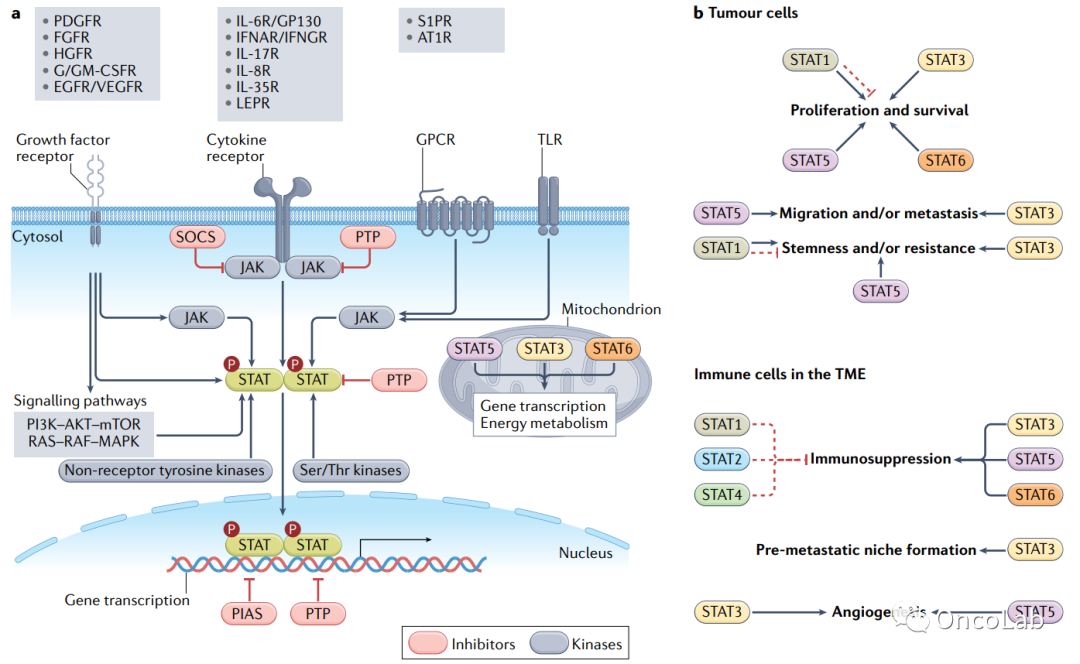
STAT proteins in cancer: orchestration of metabolism
STAT蛋白在癌症中的作用:对代谢的调节
Nat Rev Cancer. 2023 Jan 3.
doi: 10.1038/s41568-022-00537-3.
PubMed: https://pubmed.ncbi.nlm.nih.gov/36596870/
Abstract
Reprogrammed metabolism is a hallmark of cancer. However, the metabolic dependency of cancer, from tumour initiation through disease progression and therapy resistance, requires a spectrum of distinct reprogrammed cellular metabolic pathways. These pathways include aerobic glycolysis, oxidative phosphorylation, reactive oxygen species generation, de novo lipid synthesis, fatty acid β-oxidation, amino acid (notably glutamine) metabolism and mitochondrial metabolism. This Review highlights the central roles of signal transducer and activator of transcription (STAT) proteins, notably STAT3, STAT5, STAT6 and STAT1, in orchestrating the highly dynamic metabolism not only of cancer cells but also of immune cells and adipocytes in the tumour microenvironment. STAT proteins are able to shape distinct metabolic processes that regulate tumour progression and therapy resistance by transducing signals from metabolites, cytokines, growth factors and their receptors; defining genetic programmes that regulate a wide range of molecules involved in orchestration of metabolism in cancer and immune cells; and regulating mitochondrial activity at multiple levels, including energy metabolism and lipid-mediated mitochondrial integrity. Given the central role of STAT proteins in regulation of metabolic states, they are potential therapeutic targets for altering metabolic reprogramming in cancer.
代谢重编程是癌症的一个重要标志。然而,从肿瘤发生到疾病进展和耐药,癌症的代谢会发生一系列不同的重编程细胞代谢途径。这些途径包括有氧糖酵解、氧化磷酸化、活性氧生成、脂质从头合成、脂肪酸β-氧化、氨基酸(尤其是谷氨酰胺)代谢和线粒体代谢。这篇综述强调了信号转导和转录激活因子(STAT)蛋白,尤其是STAT3, STAT5, STAT6和STAT1,在协调肿瘤细胞、免疫细胞和脂肪细胞在肿瘤微环境中的高度动态代谢中的核心作用。STAT蛋白能够通过转导来自代谢物、细胞因子、生长因子及其受体的信号来形成调节肿瘤进展和治疗抵抗的独特代谢过程;确定调节参与癌症和免疫细胞代谢重编程的广泛分子的遗传程序;以及在多个水平调节线粒体活性,包括能量代谢和脂质介导的线粒体完整性。鉴于STAT蛋白在代谢状态调节中的核心作用,它们是改变癌症中代谢重编程的潜在治疗靶点。
▉ 强烈推荐
▉ OncoLab实验室网站
本公众号上的往期文章同步发布至对应网站OncoLab实验室。
网站自带检索功能,可以根据关键词进行检索,并且可以根据日期及内容分类进行查看 ,大家可以收藏方便在电脑上查看。
网址是:oncolab.cn
▉ OncoLab学术导航
此外,梳理了一下这几年攒的收藏夹,做了一个导航网页,包含常用网站、文献阅读、试剂订购、基金相关、实用工具、常用数据库等分类内容,并且整合了百度、谷歌、必应三大搜索引擎到检索工具中,欢迎收藏或设置为主页使用~
网址是:dh.oncolab.cn
▉ OncoLab知识星球
OncoLab知识星球也已开通,在学习本公众号内容的过程中如果有什么需要讨论交流的地方可以在星球发表留言,也可以分享一下自己的学习心得体会,其他小伙伴看到了可以积极留言回复,我也会积极参与其中,并时常放一些学习资料在上面,希望大家能够在积极交流互帮互助中共同进步~
该星球用于OncoLab公众号读者交流学习使用,永久免费。

关注本号~

加入读者交流群~
(添加请备注单位姓名)

加入知识星球~
本篇文章来源于微信公众号:OncoLab


